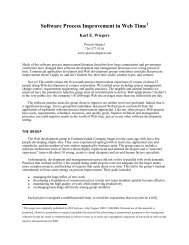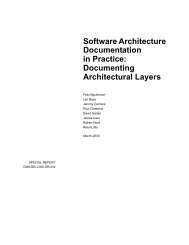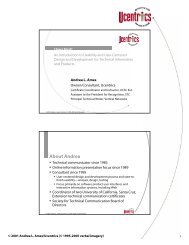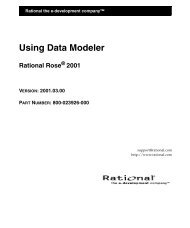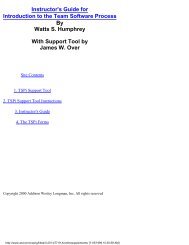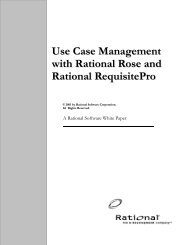RSI - A Structured Approach Use Cases and HCI Design
RSI - A Structured Approach Use Cases and HCI Design
RSI - A Structured Approach Use Cases and HCI Design
You also want an ePaper? Increase the reach of your titles
YUMPU automatically turns print PDFs into web optimized ePapers that Google loves.
The <strong>RSI</strong> <strong>Approach</strong> To <strong>HCI</strong> <strong>Design</strong> / <strong>Use</strong> Case Analysis Page 15 of 42<br />
• a goal oriented decomposition of the use case into a sequence of steps - labelled<br />
according to whether they are to be automated or not<br />
• a list of any extensions dealing with deviations <strong>and</strong> exceptions in the normal sequence<br />
of events (Cockburn's exception numbering convention is particularly useful in these<br />
descriptions)<br />
Requirement use cases provide the starting point from which decisions regarding the scope<br />
<strong>and</strong> phasing of the functionality can be made. The individual steps (sub-goals) within the<br />
description are c<strong>and</strong>idates for potential automation.<br />
The objectives of developing the requirements use case model are to clearly document the<br />
business drivers for a system in as concise a manner as possible. Requirement use cases may<br />
be decomposed (using the «includes» relationship) for the purposes of removing duplication<br />
of text across multiple use case descriptions.<br />
The target audience for requirement use cases is primarily end users. Developing requirement<br />
use cases falls within the remit of a typical business analyst's role.<br />
3.2.2. Interface <strong>Use</strong> <strong>Cases</strong><br />
Interface use cases describe functionality that is concerned with managing the interface<br />
between the actors of a system <strong>and</strong> the underlying services it offers. Interface use cases<br />
undertake the role of 'translating' the information provided by an actor into a form acceptable<br />
to a set of underlying service use cases. To do this, they factor out the elements of<br />
functionality that are more related to the interface than to the underlying system. Interface use<br />
cases may be documented as follows:<br />
• the objectives of the interface<br />
• a detailed description of any interface formats used. This might include user interface<br />
design (dialogs, etc.), report layouts, file formats, etc.<br />
• a step by step description of the functional aspects of the interface such as user interface<br />
dynamics (e.g. "when the 'select customer' button is clicked, the 'accounts' list-box is<br />
refreshed"), file processing, how report contents are made up, etc.<br />
An alternative to the latter two documentation items is to develop an interface prototype.<br />
The objectives of developing the interface use case model are to clearly document (or<br />
demonstrate in the case of an interface prototype) the interfaces used by a system in as<br />
concise a manner as possible, providing traceability to antecedent requirement use case<br />
descriptions. Interfaces may be decomposed using the «includes» stereotype to show use of<br />
one interface use case (<strong>and</strong> user interface element) by another.<br />
The target audience for interfaces use cases is primarily end users. Developing interfaces falls<br />
within the remit of the user-interface designer's role.<br />
W5a - <strong>RSI</strong> LONG PAPER [42 PAGES].doc( Rev: 5) - 03/09/00



